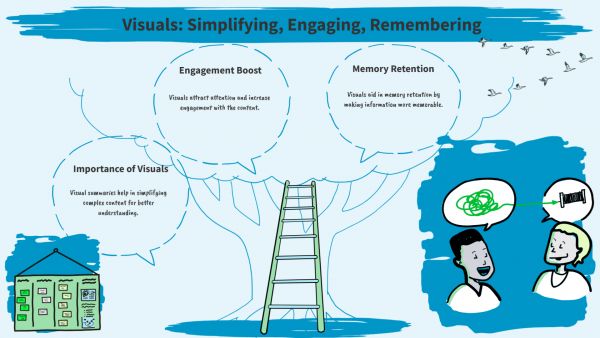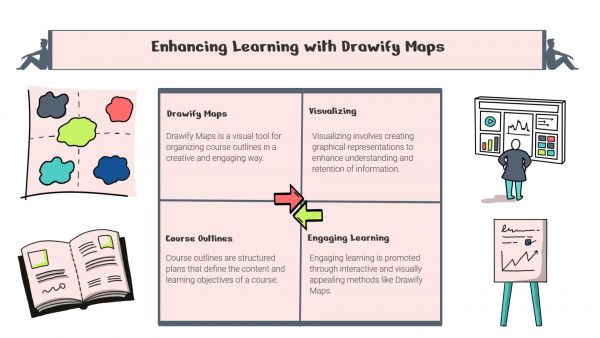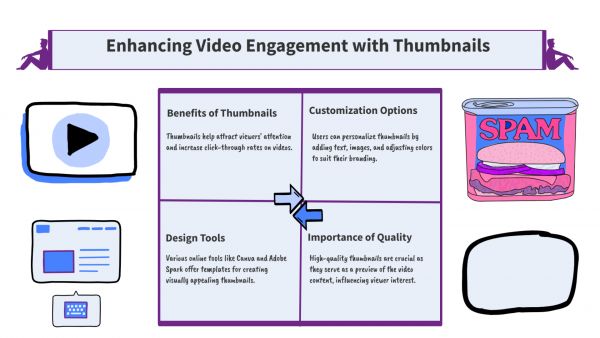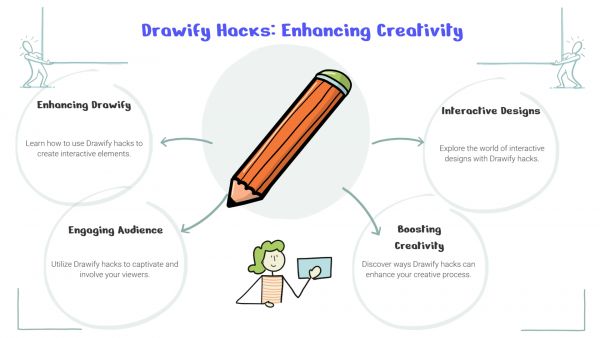Whether you've got stories to tell or art to create, there's a place for you here.

Online Course Creators
Collaborative Drawify for Course Challenges
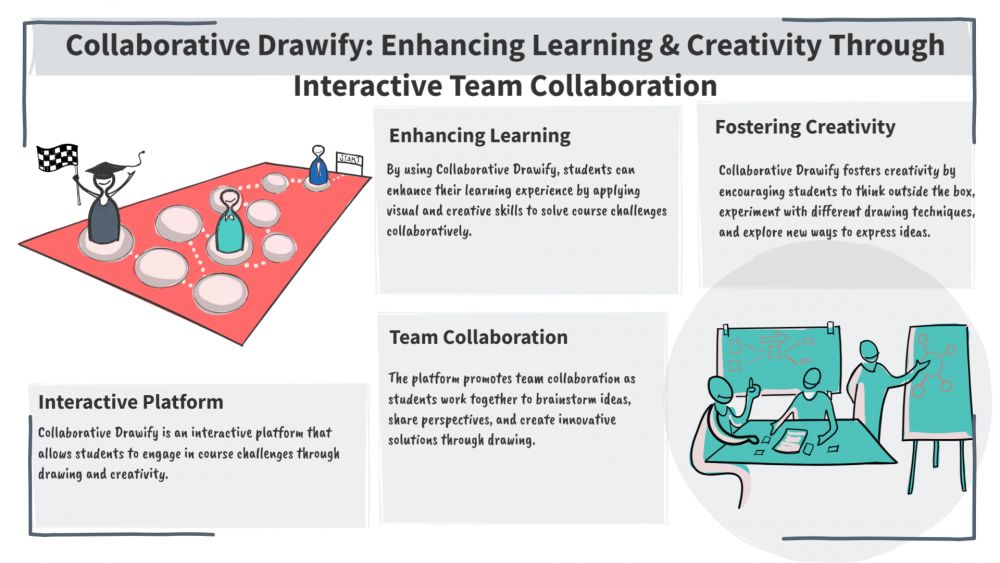
-
SDSwarnali Das- Co-founder, Chief Product Officer, Drawify
-
Sep 28, 2025 5 min read
Visual communication has become an essential part of successful learning in the ever-changing field of digital education. With Collaborative Drawify, typical text-based assignments are transformed into dynamic, visually rich collaborative experiences that improve understanding, engagement, and creative problem-solving. This transforms the way educators and students approach course difficulties.
The Educational Revolution: From Text to Visual Collaboration
Innovative solutions that support a variety of learning styles and encourage active engagement are needed to address today's educational issues. Students who thrive in collaborative work and visual processing are typically limited by the written submissions that are a common feature of traditional course challenges. Collaborative Drawify fills this gap by utilising the platform's vast collection of over 50,000 hand-drawn images and AI-powered Maia technology to establish a setting where students can work together to solve challenging challenges through visual storytelling.
The collaborative nature of Drawify transforms isolated learning experiences into community-driven educational journeys. Students can work together in real time, combining their diverse perspectives and creative approaches to visualise solutions, present research findings, and communicate complex concepts through professional-quality illustrations.

Technical Architecture for Educational Collaboration
Multi-User Workspace Integration
Collaborative Drawify's technical infrastructure supports seamless multi-user environments where students and instructors can simultaneously access and contribute to shared projects. The platform's cloud-based architecture ensures that all collaborators have real-time access to updates, changes, and contributions, eliminating the version control issues commonly associated with traditional collaborative tools.
The platform's drag-and-drop functionality becomes particularly powerful in educational settings, allowing team members to quickly reorganise visual elements, test different narrative structures, and experiment with various illustration combinations without requiring technical expertise or artistic skills.
Pedagogical Applications Across Disciplines
STEM Education and Complex Problem Visualisation
In science, technology, engineering, and mathematics courses, Collaborative Drawify excels at helping students visualise abstract concepts and complex processes. Teams can collaborate to create detailed diagrams showing scientific processes, illustrate mathematical concepts through visual metaphors, or design technical flowcharts that demonstrate their understanding of engineering principles.
For instance, a chemistry course challenge might involve teams collaborating to create visual stories explaining molecular interactions, with each student contributing different aspects of the process while the group collectively ensures scientific accuracy and visual coherence.
Humanities and Social Sciences Storytelling
Collaborative Drawify's narrative powers are extremely beneficial to liberal arts subjects. History courses can use the platform for collaborative timeline building, where students work together to illustrate historical events, their interconnections, and their modern relevance. Through collaborative drawing projects, literature courses can use the platform to produce visual versions of intricate stories, giving students the chance to investigate literary methods, character development, and thematic elements.
The platform's extensive library of artistic styles enables teams to match their visual approach to their subject matter, whether creating period-appropriate illustrations for historical content or modern interpretations of classical themes.
Business and Communication Studies
Marketing and business communication courses find particular value in Collaborative Drawify. Student teams can work together to develop visual marketing campaigns, create collaborative presentations for business proposals, or design comprehensive brand storytelling projects that require input from multiple team members with different expertise areas.
Implementation Strategies for Maximum Educational Impact
Structured Collaboration Frameworks
Successful implementation of Collaborative Drawify in course challenges requires thoughtful pedagogical design. Educators should establish clear collaboration protocols that define roles, responsibilities, and contribution expectations for each team member. This might include designating visual researchers, content creators, technical coordinators, and quality assurance reviewers within each collaborative group.
The platform's composition tools support this structured approach by allowing teams to divide complex challenges into manageable components, with each member focusing on their area of expertise while contributing to the overall visual narrative.
Progressive Skill Development
Course challenges using collaborative Drawify should be designed with progressive complexity, starting with simple collaborative exercises that familiarise students with the platform's capabilities and gradually advancing to more sophisticated projects that require advanced visual storytelling techniques and complex collaboration coordination.
Early challenges might focus on basic template customisation and simple collaborative editing, while advanced projects could involve creating original visual narratives from scratch, integrating multimedia elements, and coordinating complex multi-part presentations.
Assessment and Evaluation Methodologies
Evaluating collaborative visual projects requires multifaceted assessment approaches that consider both individual contributions and team outcomes. Instructors can utilise Drawify's revision history and collaboration tracking features to assess individual student contributions, creative problem-solving approaches, and collaborative effectiveness.
Assessment criteria should encompass technical execution, creative innovation, content accuracy, collaborative process effectiveness, and final presentation quality. This comprehensive evaluation approach ensures that students are rewarded for both their individual efforts and their ability to work effectively within collaborative teams.
Overcoming Traditional Educational Barriers
Accessibility and Inclusion
Many accessibility issues with conventional teaching methods are addressed by Collaborative Drawify. While students with diverse learning styles can bring their talents to group assignments, those who struggle with textual expression can thrive through visual communication. Students of all technical and artistic backgrounds can now access sophisticated visual storytelling thanks to the platform's user-friendly design.
Time Efficiency and Resource Management
Traditional collaborative projects often suffer from coordination challenges, version control issues, and time management difficulties. Collaborative Drawify streamlines these processes by providing a unified platform where all collaboration occurs in real time, eliminating the need for complex file-sharing systems and reducing the administrative overhead associated with group projects.
The platform's template system and extensive asset library significantly reduce the time required to create professional-quality visual content, allowing students to focus on content development, creative problem-solving, and collaborative learning rather than technical implementation challenges.
Advanced Collaborative Features and Capabilities
Multi-Format Export for Comprehensive Presentations
Collaborative teams can leverage Drawify's multi-format export capabilities to create comprehensive presentation packages that include static illustrations, animated sequences, and interactive elements. This flexibility allows teams to tailor their final deliverables to specific presentation contexts, whether they're creating materials for live presentations, online portfolios, or printed reports.
Integration with Educational Technology Ecosystems
Collaborative Drawify's compatibility with various educational platforms and learning management systems enables seamless integration into existing course structures. Teams can easily share their collaborative work through institutional portals, embed visual content in course discussions, and maintain organised project portfolios that demonstrate learning progression over time.
Future Implications for Educational Technology
Preparing Students for Professional Collaboration
The collaborative skills students develop through Drawify-based course challenges directly translate to professional environments where visual communication and team-based problem-solving are increasingly important. Students learn to navigate creative differences, coordinate complex projects, and communicate effectively through visual media – skills that are highly valued in contemporary professional settings.
Scaling Visual Education Across Institutions
As educational institutions recognise the value of visual collaboration tools, Collaborative Drawify provides a scalable solution that can support everything from small seminar courses to large lecture-based classes. The platform's cloud-based infrastructure can accommodate varying class sizes and institutional requirements while maintaining consistent functionality and user experience.
More than just a technical tool, Collaborative Drawify symbolises a fundamental change towards more effective, inclusive, and engaging teaching strategies. The platform accommodates a variety of learning styles, encourages active participation, and equips students for the collaborative, visually orientated professional settings they will face after graduation by converting course challenges from individual, text-based exercises into collaborative, visually rich learning experiences.
The platform's combination of advanced AI technology, extensive artistic resources, and intuitive collaborative features creates unprecedented opportunities for educational innovation. As educators continue to explore and implement these capabilities, Collaborative Drawify is positioned to become an essential component of modern educational technology ecosystems, fundamentally transforming how students learn, collaborate, and demonstrate their understanding of complex concepts.
Through thoughtful implementation and strategic integration into course curricula, Collaborative Drawify has the potential to revolutionise educational experiences, creating more engaging, inclusive, and effective learning environments that prepare students for success in our increasingly visual and collaborative world.
- Events
- Workshops
- Visual Storytelling
- How to video
- Communities
- Sketchnoting
- Templates
- UX Designers
- Agile Professionals
- Product Managers
- Freelance Graphic Designers
- Creative Tech Enthusiasts
- Online Course Creators
- Social Media Content Creator
- Creative Agency Owners
- Marketing Professionals
- EdTech Professionals
- Scrum Masters
Come, Be Part of Something Special
-
Got ideas that need visual superpowers?
Jump in and start creating presentations and communications that people actually remember.
Sign In -
Are you an artist ready to grow?
Join our Drawifier family and focus on what you love most - creating art that matters.
Become a Drawifier
Get visualisation tips every week
Subscribe to the Drawify Newsletter, and feed your creativity with visualisation tips and techniques, as well as the latest Drawify workshops, news and resources.
